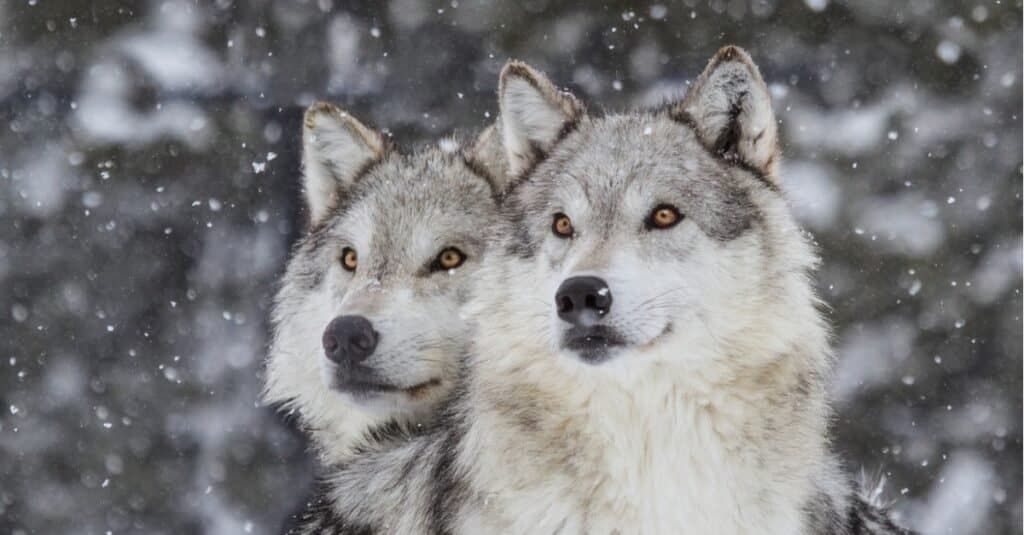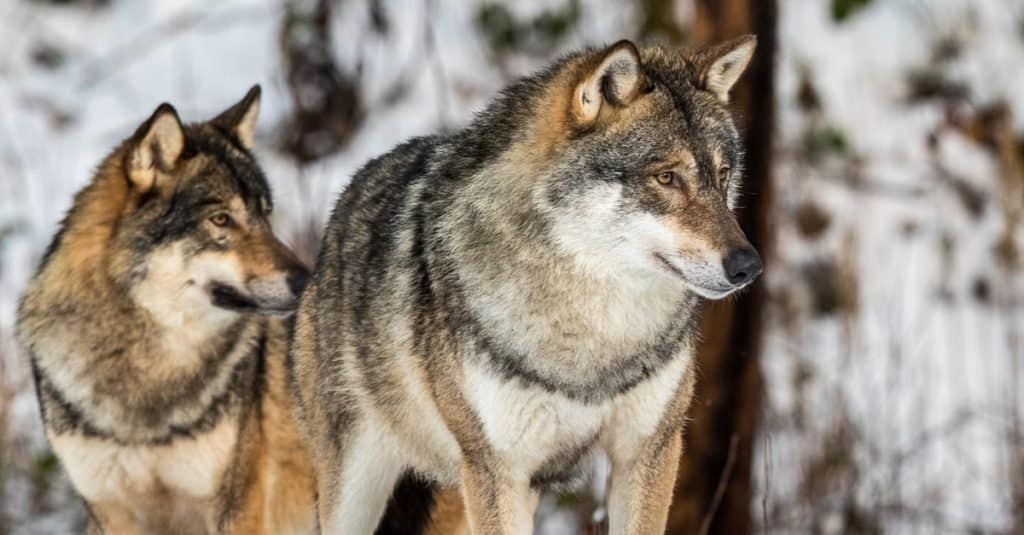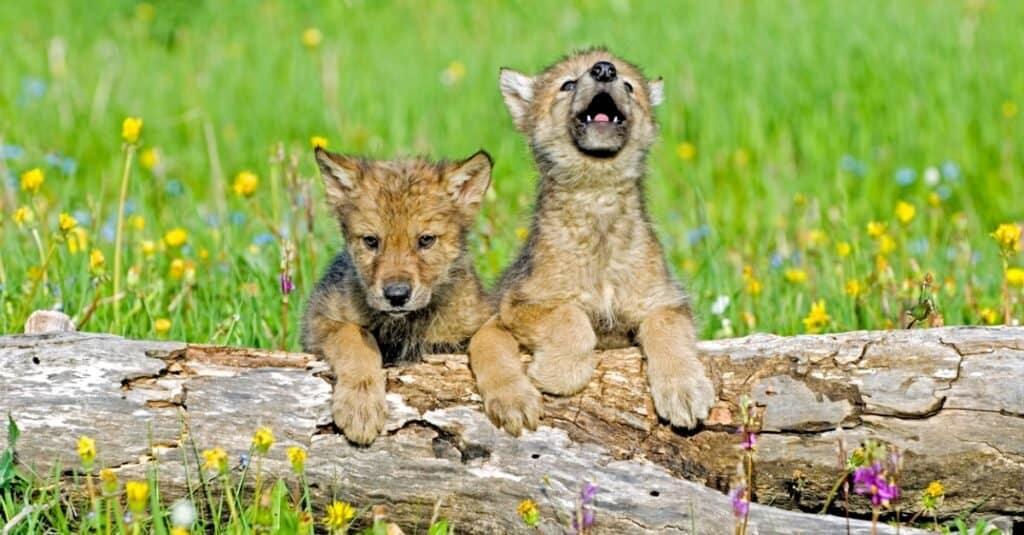While it may sound surprising, there are a number of gray wolves in Yellowstone National Park. In fact, Yellowstone is considered one of the best places in the world to safely view wolves in their natural habitat! If you are planning a visit to this infamous National Park, what can you expect in terms of wildlife, especially the gray wolf population?
In this article, we will go over everything you need to know about the wolf population in Yellowstone National Park, including how many live in Yellowstone at any given time. We will also go over some park etiquette should you happen to see any wolves during your visit, as well as when and where these reclusive creatures are most active. Let’s get started!
Key Information About Wolves in Yellowstone National Park

T
here are an estimated 100 wolves that currently live in Yellowstone, with over 500 living in the greater Yellowstone region and ecosystem.
©iStock.com/rogertrentham
| Yellowstone National Park | Wolf Facts |
|---|---|
| Number in the Park | 100-500 in the greater Yellowstone area |
| Average Size | 80-130 pounds; 4-6 feet long |
| Mating Season | February, with pups born in April |
| Diet | Elk, rabbits, deer, bison |
| Active Times | All times, but particularly dawn and dusk |
| Best Viewing Locations | Most of the park, particularly the Northern Range |
How Many Wolves Live in Yellowstone National Park?

Through tracking and other measures taken by Yellowstone National Park Rangers, they have discovered that the gray wolves in Yellowstone venture anywhere from 100-300 miles, depending on the pack.
©Lillac/Shutterstock.com
Determining the number of wolves in Yellowstone National Park can be difficult, given the huge amount of territory that these animals wander through. In addition, wolves in Yellowstone can be hunted and otherwise killed by humans legally in some states that the park occupies. While hunting is not permitted in Yellowstone National Park itself, nearby states can be dangerous for the gray wolf, and this is why the number fluctuates frequently.
However, there are an estimated 100 wolves that currently live in Yellowstone, with over 500 wolves living in the greater Yellowstone region and ecosystem. In fact, 2020 marked the 25th anniversary of the gray wolf being reintroduced into Yellowstone National Park, and the population is frequently tracked and monitored.
Through tracking and other measures taken by National Park Rangers, they have discovered that these animals in Yellowstone venture anywhere from 100-300 miles, depending on the pack. This is considered the range of travel and territory that the wolves deal with daily; it is their home turf, in a way. While it is largely weather and food-driven as to where these wolves spend their time, it also means you have a chance of seeing them in action!
How Large are Wolves in Yellowstone National Park?

Gray wolves are just another apex predator in the greater Yellowstone ecosystem, alongside grizzly bears.
©Holly S Cannon/Shutterstock.com
While gray wolves may seem small from a distance (be sure to only view wolves from over 100 yards in Yellowstone), they are much larger than your average dog. In fact, depending on gender, gray wolves can reach anywhere from 80-130 pounds and up to six feet in length. This makes them just another apex predator in the greater Yellowstone ecosystem, alongside grizzly bears.
An interesting observation that has occurred within the Yellowstone wolf population is the presence of two different colors of wolf: both black and gray wolves exist in equal amounts. According to genetic studies performed by Yellowstone National Park, black-coated gray wolves have higher resistance to certain diseases as well as less aggression during territorial disputes.
When are Wolves Most Active in Yellowstone National Park?

While wolf sightings aren’t exactly rare in Yellowstone National Park, it’s best not to get your hopes up too high!
©Lillian Tveit/Shutterstock.com
Wolves can be viewed during any time of day in Yellowstone, though many people consider wolves to be crepuscular. This means that they are most active during dawn and dusk, alongside many other animals in the park, such as grizzlies and most ungulate populations. This is likely why the gray wolf is most active during this time of day as well- they are busy hunting a variety of prey, including elk and deer!
However, given the innate randomness of wolf behavior and the number of wolf packs competing for territory within the park, seeing a gray wolf during a specific time of day is next to impossible to predict. While wolf sightings aren’t exactly rare in Yellowstone National Park, it’s best not to get your hopes up too high!
Where Can I View Wolves in Yellowstone National Park?

Given the fact that wolves roam and range in terms of their territory, you may not find any during your visit to Yellowstone.
©iStock.com/JohnPitcher
Yellowstone National Park’s northern regions are some of the best locations in the entire world to view gray wolves in a natural, wild habitat. While the population roams through the entire park and nearby regions, the Northern Range has the best success for seeing just about any carnivore.
If you are hoping to see young wolf pups, early spring is a fantastic time to do this. While pups stay close to their mothers for much of their early life, they emerge from their dens and begin to learn how to hunt during this time of year. If you don’t mind a few road closures and some snow on the ground, visiting Yellowstone National Park during the months of April and May is an especially good time to see wolves and other animals!
However, given the fact that wolves roam and range in terms of their territory, you may not find any during your visit. Winter in Yellowstone is a great time to see wildlife, if you can brave the cold. This is the time of year that many species venture into the warmer valleys, closer to human populations. You may get lucky and see the elusive gray wolf in person!
The photo featured at the top of this post is © iStock.com/slowmotiongli
Thank you for reading! Have some feedback for us? Contact the AZ Animals editorial team.






